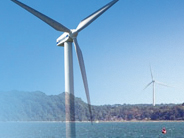by Reuters
Wind turbines that do not interfere with radar systems used by aircraft may soon become a commercially viable option for the wind energy industry, Danish turbine manufacturer Vestas said today.
“Our testing has demonstrated that we have successfully adapted military stealth technology to make Vestas wind turbines viable for placement in many locations that have been restricted by radar concerns,” Vestas Technology R&D President Finn Strom Madsen said in a statement.
Vestas said it successfully tested in Britain a full-scale “stealth” rotor on a turbine, paving the way for wind power plants to be located near military installations, airports, and other radar systems without interfering with their operations.
 Stealth technology was initially developed by the U.S. military starting in the late 1950s to prevent radar tracking of spy planes and is currently used in the Northrop Grumman B-2 Spirit “Stealth Bomber.”
Stealth technology was initially developed by the U.S. military starting in the late 1950s to prevent radar tracking of spy planes and is currently used in the Northrop Grumman B-2 Spirit “Stealth Bomber.”
Stealth turbines are made with radar-absorbing materials, which can almost entirely eliminate the reflection of radar waves off the turbine, Vestas said.
“This is a critical step toward the commercialization of stealth turbines and holds potential to open a significant number of wind power locations for Vestas customers,” Madsen said.
An estimated 20 gigawatts of wind power capacity is currently blocked worldwide by concerns about radar interference, Vestas said.
Vestas presented test results at the International Wind and Radar Forum in Ottawa, Canada, showing that a Vestas turbine with a stealth rotor achieved a targeted reduction in radar reflection of about 99 percent compared with standard turbines.
“This means that when the radar waves strike the stealth-treated turbines, only 1 percent is reflected back,” Jeffrey Awalt, a Vestas R&D spokesman, told Reuters.
Related links
• Tech fixes to wind turbine-radar conflict face hurdles
• Wind power growth limited by radar conflicts
Vestas has been working on stealth turbines with its British technology partner QinetiQ since 2006.
“At this point, this is not something we have on the market,” Awalt said.
“We do expect that this will develop into a commercial product,” he said, but added that it was not possible to say when the technology could be marketed.
“We haven’t determined exactly what the cost will be, but we don’t expect that it will be a significant additional cost for the turbine,” Awalt said.
Source: cnet

 Follow
Follow